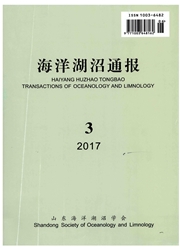

 中文摘要:
中文摘要:
本文根据2009年5月、9月和12月海州湾水域生物资源的调查资料,分析了海州湾水域蟹类资源密度的分布,多样性及蟹类优势种对蟹类数量分布的影响。结果表明,5月、9月和12月蟹类质量密度分别为36.15、53.85和44.91kg/km^2,尾数密度为6.33×10^3、3.13×10^3和35.88×10^3ind./km^2。5月、9月和12月蟹类以质量计算的物种多样性分别是0.95、0.64和0.65,以尾数计算的物种多样性分别是0.96、1.01和0.61。海州湾水域以广温广盐性蟹类为主,5月、9月和12月的最重要的优势种分别为双斑蜉(Charybdis bimaculata)、日本蜉(Charybdis japonica)和豆形短眼蟹(Xenophthalmus pinnotheroides)。春季蟹类的密度分布规律不明显;秋季蟹类的密度分布除湾外个别站位很高之外,其余站位分布均匀;冬季蟹类的密度分布沿岸稍高于湾外。季节变化很大程度上影响了优势种的改变。不同季节,蟹类优势种类的绝对优势,使得蟹类多样性平面分布与蟹类密度分布存在差异。
 英文摘要:
英文摘要:
Based on the data of living resource obtained in Haizhou Bay in May, September and Decem- ber 2009, the effect of distribution of crab resource density, diversity and dominant species on the biomass distribution of the crabs was studied. In May, September and December, the densities of crab weights were 36.15 kg/km^2 , 53.85 kg/km^2 and 44.91 kg/km^2 , and the densities of crab numbers were 6.33 103 ind./km^2 , 3.13 103ind./km^2 and 35.88 103ind./km^2 , respectively. Yet, the weight diversities of the crabs were 0.95, 0.64, and 0.65, the number diversities of the crabs were 0.96, 1.01, and 0. 61, respectively. Most of the crabs were eurythermal and eurysaline species. The most important dominant crabs were Charybdis birnaculata in May, Charybdis japonica in September and Xenophthalrnus pinnotheroides in December. The distribution pattern of crab density was not obvious in spring, the distribution of crab density in the most of stations was well distributed, except the individual sta- tion in autumn; the distribution of crab density in coastal area was higher than that in outer bay. The dominant crabs varied with the seasons largely. In the different seasons, as the dominant crabs were absolutely advantage, the horizontal distributions of crab diversities and distribution of crab densities had difference.
 同期刊论文项目
同期刊论文项目
 同项目期刊论文
同项目期刊论文
 期刊信息
期刊信息
